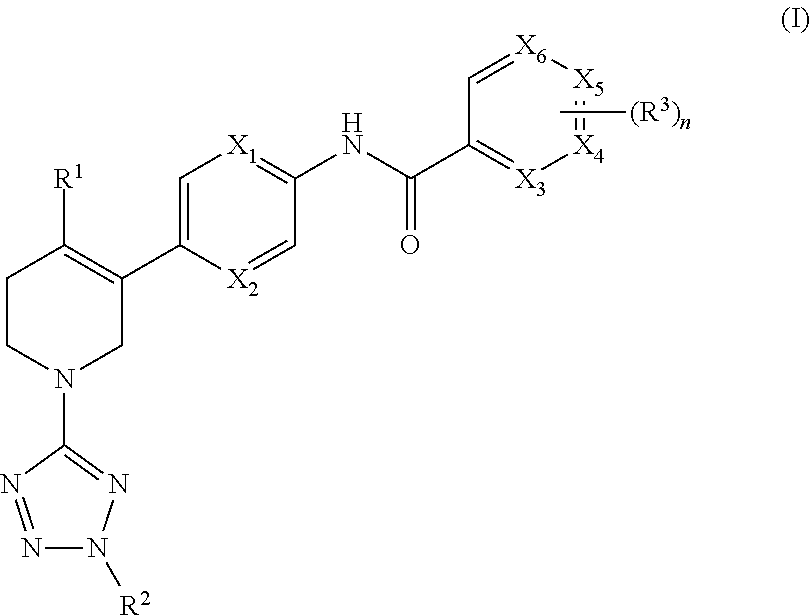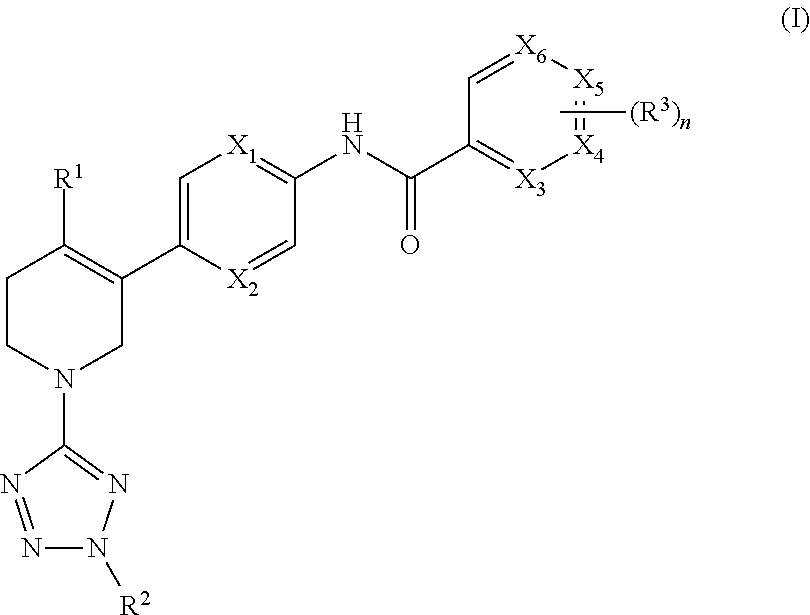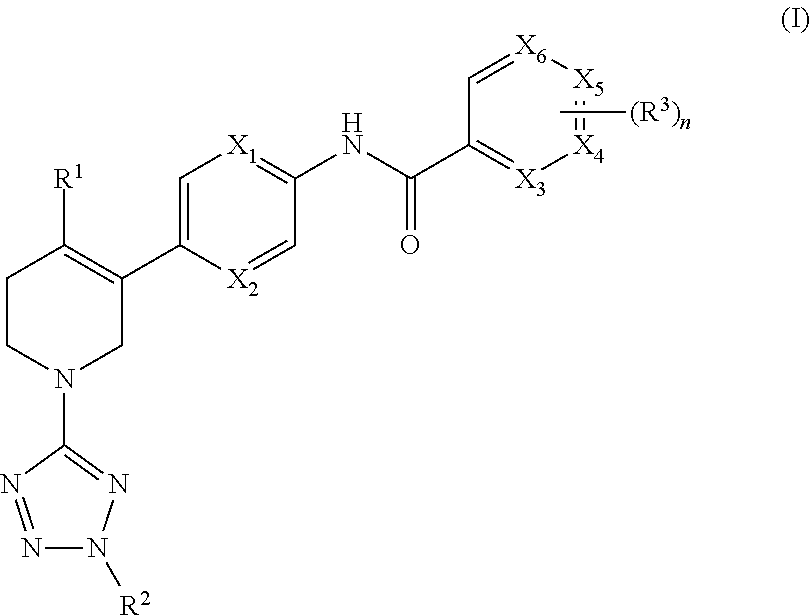Tetrazolyl-tetrahydropyridine compounds for inflammation and immune-related uses
a technology of tetrazolyl pyridine and tetrahydropyridine, which is applied in the field of biologically active chemical compounds, can solve the problems of inert antigenic stimulation, tissue damage, and the inability to inhibit il-2 production, and achieve the effects of reducing side effects, reducing drug side effects, and improving anti-inflammatory
- Summary
- Abstract
- Description
- Claims
- Application Information
AI Technical Summary
Benefits of technology
Problems solved by technology
Method used
Image
Examples
specific embodiments
[0064]The invention relates to compounds according to Formuale I, IIa, IIb, IIIa, IIIb, IIIc, IVa, IVb, and IVc as described herein, compounds in Table 1, and pharmaceutical compositions that are particularly useful for immunosuppression or to treat or prevent inflammatory conditions, immune disorders, and allergic disorders.
[0065]Values and particular values for the variables of Formulae I, IIa, IIb, IIIa, IIIb, IIIc, IVa, IVb, and IVc, where present, are described below.
[0066]Each of X1 and X6 is independently N or CH. X1 and X2 can both be N. X1 and X2 can both be CH. X1 can be CH when X2 is N. X1 can be N when X2 is CH.
[0067]Each X3, X4, X5, and X6 is independently N or CH. All X3, X4, X5, and X6 are CH. X3 is N, and X4, X5, and X6 are CH. X4 is N, and X3, X5, and X6 are CH. X5 is N, and X3, X4, and X6 are CH. X6 is N, and X3, X4, and X5 are CH. X3 and X5 are N, and X4 and X6 are CH. X4 and X6 are N, and X3 and X5 are CH.
[0068]R1 is halo, (C1-C4)alkyl, or (C3-C7)cycloalkyl. In s...
example 1
Synthesis of N-(4-(1-cyano-4-methyl-1,2,5,6-tetrahydropyridin-3-yl)phenyl)acetamide
[0136]
[0137]N-(4-(1-benzyl-4-methyl-1,2,5,6-tetrahydropyridin-3-yl)phenyl)acetamide (3.67 g, 11.45 mmol) was dissolved in methylene chloride (150 ml). Solid cyanogen bromide was added and stirred for 30 minutes. Saturated sodium bicarbonate was added. The methylene chloride layer was extracted with brine and dried with sodium sulfate. The compound was purified with flash chromatography using a methylene chloride and methanol gradient to produce 2.61 g (89% yield) of a viscous oil.
example 2
Synthesis of N-(4-(4-methyl-1-(2-methyl-2H-tetrazol-5-yl)-1,2,5,6-tetrahydropyridin-3-yl)phenyl)acetamide
[0138]
[0139]A solution of N-(4-(1-cyano-4-methyl-1,2,5,6-tetrahydropyridin-3-yl)phenyl)acetamide (3.67 g, 14.37 mmol), ammonium chloride (2.31 g, 43.1 mmol) and sodium azide (2.80 g, 43.1 mmol) in DMF (25 ml) was heated to 100° C. for 1 hour. The solution was then cooled to room temperature. Methylene chloride was added followed by water and an aqueous workup. After drying with Na2SO4 and removing methylene chloride, the residue was dissolved in isopropanol. Excess TMS-diazomethane was added and the mixture was stirred for 10 minutes. The reaction mixture was purified by flash chromatography to provide a 6:1 mixture of isomers with the major isomer as the desired product. Overall yield was around 60% over two steps (2.67 g). The crude product was used directly in the next step without further purification.
PUM
| Property | Measurement | Unit |
|---|---|---|
| temperature | aaaaa | aaaaa |
| weight percent | aaaaa | aaaaa |
| weight percent | aaaaa | aaaaa |
Abstract
Description
Claims
Application Information
 Login to View More
Login to View More - R&D
- Intellectual Property
- Life Sciences
- Materials
- Tech Scout
- Unparalleled Data Quality
- Higher Quality Content
- 60% Fewer Hallucinations
Browse by: Latest US Patents, China's latest patents, Technical Efficacy Thesaurus, Application Domain, Technology Topic, Popular Technical Reports.
© 2025 PatSnap. All rights reserved.Legal|Privacy policy|Modern Slavery Act Transparency Statement|Sitemap|About US| Contact US: help@patsnap.com



